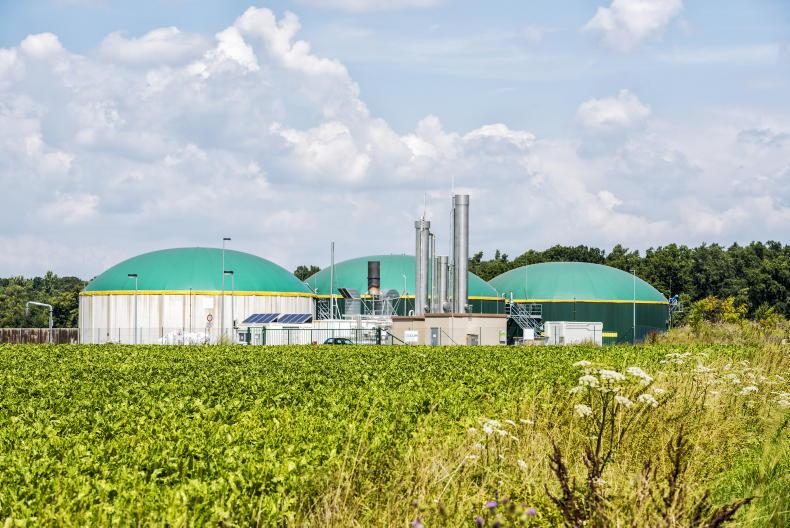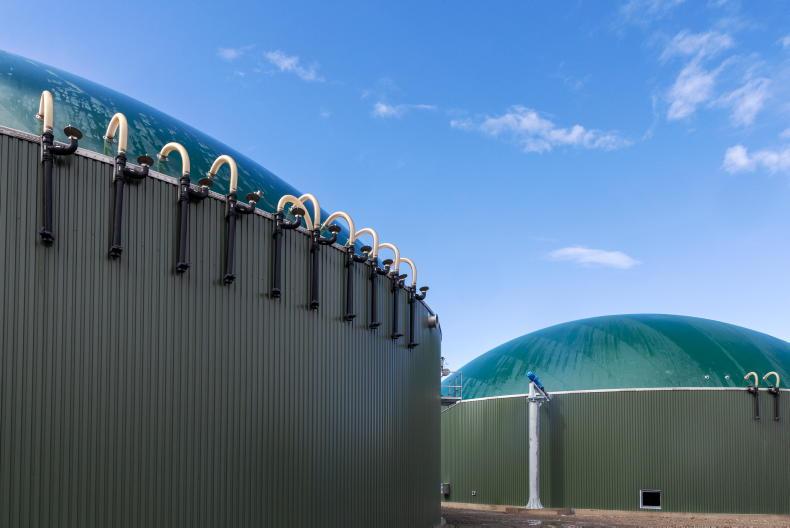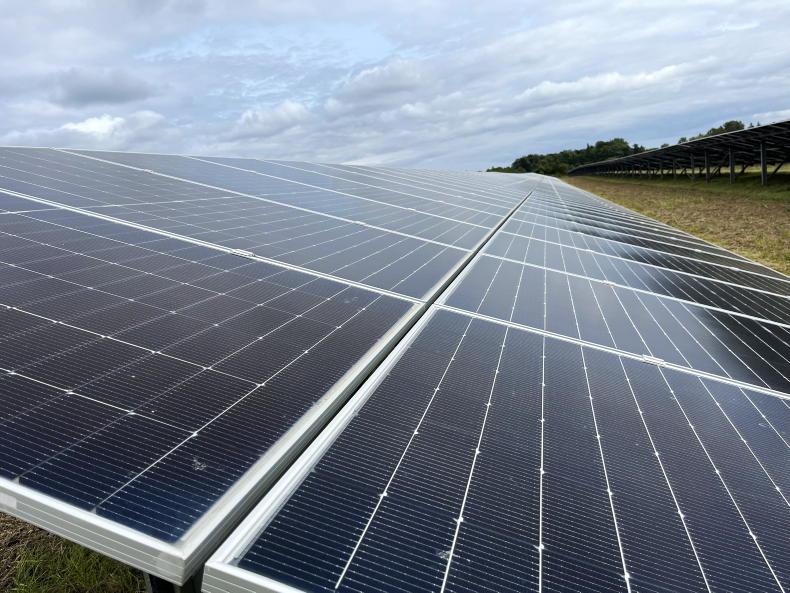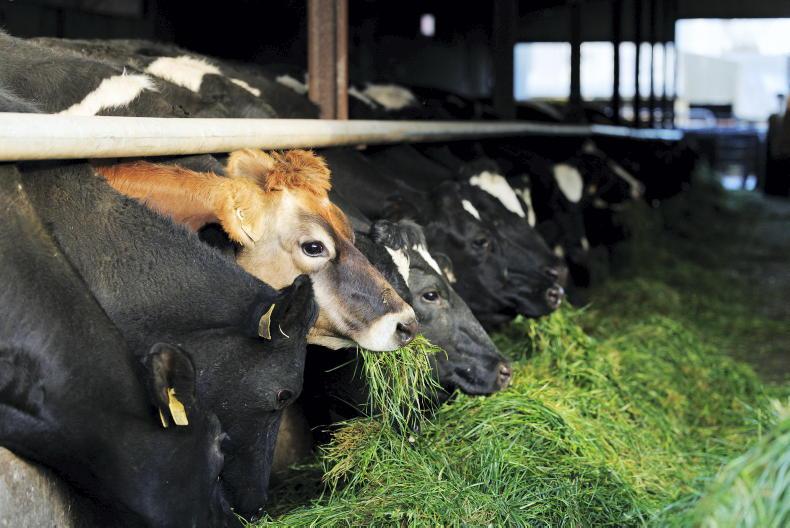Last week, news broke that the derogation will drop from 250kg N/ha to 220kg N/ha from 1 January.
The move directly impacts some 3,000 farmers, mostly dairy farmers, who have warned that the wider agricultural sector will also be impacted, as they will now need more land to continue to operate at current levels.
Furthermore, the news came with warnings that the derogation level for 2024 is not safe and that significant work to improve water quality would be needed to prevent it dropping further.
The news took centre stage in last week’s coverage, with farm organisations and ministers facing many questions from both farmers and journalists.
The topic also came up during Minister Eamon Ryan’s keynote address at the Energy Ireland renewable gas conference.
Minister Ryan told a packed room full of conference delegates that, while some dairy farmers may consider taking on more land to deal with the new limits, another option for farmers is to become involved with the energy transition to biomethane.
He said that if dairy farmers produce grass for anaerobic digestion (AD) plants instead of producing grass to feed cows, thereby reducing cow numbers, this will help them meet the new derogation limit.

Minister Ryan thinks that the dairy farmers impacted by the new derogation limits will be central in the first wave of AD development.
He believes that many dairy farmers will see this as a profitable option to meet the new limits, and that these farmers will be central in the first wave of AD development.
Can AD help dairy farmers?
The reality, however, is that AD is of no use to the 3,000 farmers impacted by the derogation changes in 2024 because, quite simply, a scaled-up AD industry doesn’t exist yet.
A handful of dairy farmers may be able to negotiate a deal to export slurry to the small number of operational AD plants around the country but, realistically, if they could have, they probably already would have.
So, the question is, can the emerging AD sector help the dairy sector going forward? The answer is, yes, but not necessarily as Minister Ryan suggests.
Perhaps if dairy farmers have to take on more land to maintain cow levels, and as a result have surplus grass beyond their requirements, then the AD market could be an option to sell this surplus to.
The same applies to farmers who have to reduce numbers and end up with surplus grass.
However, this option is unpalatable to many of those dairy farmers, and it is hard to see how it would be more profitable than using the grass to produce milk, despite what the minister suggests.
However, the real potential for dairy farmers within an AD sector is the option to export slurry to AD plants.
A small-scale AD plant located on a derogation dairy farm isn’t of much benefit to that farmer, as they will still have to find a home for the digestate, leaving them with the same challenge.
However, if they export their slurry to another AD plant, such as a larger centralised 40-55 GWh (gigawatt hour) plant, which Gas Networks Ireland believes will be the typical model in Ireland, then the slurry is exported off their farm and nitrates records.
Crucial flaw
However, there is one crucial flaw in this approach. Many dairy farmers will likely need to import some digestate back onto their farm to supply nutrients, particularly P and K, to silage and grazing land.
As digestate is classified as organic fertiliser, this isn’t allowed on derogation farms.
However, some in the AD industry argue that digestate should be classed as a ‘biofertiliser,’ and be treated equivalently to compound fertiliser with practically no carbon footprint. This would allow dairy farmers to import what they need.
How much slurry is needed?
The SEAI estimates that over 80% of biomethane will be produced from grass silage and cattle slurry. Slurry will be critical to the development of a sustainable AD industry.
Teagasc estimates that winter slurry from 1.3m cattle will be required to feed the AD plants to reach the 5.7TWh biomethane target
In order for grass-based AD plants to produce biomethane classed as sustainable under the EU’s Renewable Energy Directive II, a feedstock ratio of around 50:50 slurry to grass silage is needed.
Teagasc estimates that winter slurry from 1.3m cattle will be required to feed the AD plants to reach the 5.7TWh biomethane target, representing approximately 20% of all winter cattle slurry produced in Ireland.
While there are significant logistical, operational and market challenges for AD operators in taking more slurry during the winter months compared to the summer months, it is possible.
Grass from 120,000ha (under 3% of agricultural land) will also be needed to produce the required silage feedstock, which is expected to largely come from the drystock sector.
AD plants are considered energy-producing infrastructure since their primary objective is to generate renewable gases such as biomethane.
However, approximately 97% of what goes in in terms of volume, comes out the other end in the form of a uniform, pasteurised organic fertiliser known as digestate.
Dealing with digestate was often a nuisance for operational AD plants, as there’s typically more digestate produced than is needed to grow the feedstock.
Northern Ireland serves as a good example of this. As such, operators had to export the digestate to other farms, which typically came at a cost.
However, this situation changed to some extent last year when many farmers sought alternatives to chemical fertilisers, and digestate, with a higher level of available nutrients compared to slurry, became a highly attractive option.
As such, we have been looking at AD plants all wrong. Instead of viewing them solely as energy production plants, we must also look at them as nutrient management hubs. In other words, AD plants facilitate the processing and movement of nutrients from where they are in surplus to where they are needed.

AD is of no use to the 3,000 farmers impacted by the derogation changes in 2024
A key recommendation from the Food Vision tillage group is to develop a means of “nutrient exchange” from livestock farms to tillage farms to alleviate pressure on land.
AD plants offer a practical solution to help achieve this. AD operators must secure their own land base for spreading the digestate, which requires collaboration with tillage and livestock farms typically located within 20km of the AD plant.
Often, detailed nutrient management planning commences even before the construction of the AD plant. It’s a win-win as Teagasc estimates that replacing chemical fertilisers with digestate and capturing methane from slurry will lead to a saving of around 308,000 tonnes of CO2e per year.
However, a new development among the AD plants in the planning stages involves the inclusion of nutrient recovery systems.
These systems aim to reduce the volume of digestate produced, and some are being designed to convert digestate into dried, pelleted fertilisers that can be exported far beyond the 20km radius of a plant.
What AD plants
need to do
For digestate to effectively replace chemical fertilisers, farmers must be able to apply it when their crops actually require it.
Therefore, AD operators need ample storage to ensure that farmers can access it when needed, rather than when tanks need emptied.
In some cases, modern AD plants which are in the planning phase are designed with storage capacity for up to four months
This can be achieved by exporting the digestate to external storage tanks or incorporating additional storage on the AD site.
In some cases, modern AD plants which are in the planning phase are designed with storage capacity for up to four months.
Does the dairy sector want it?
To say that there is unified agreement for the development of AD to support the dairy sector wouldn’t be accurate.
In fact, there are mixed sentiments within the dairy farming community regarding this technology, with some farmers voicing concerns and viewing it as a potential competitor for land in their areas, while others are actively objecting to AD projects.
This sentiment was reflected in comments made by the ICMSA’s president, Pat McCormack.
In a 2021 Irish Farmers Journal farm leaders’ debate, McCormack said that Irish dairy co-operatives are afraid of increased competition for grass should an AD sector develop. He said that farmers would have no problem supplying slurry but “the less grass that can be put through those systems the better”.
This was in contrast to the principles of Project Clover, an initiative led by dairy co-ops to establish a number of AD plants. It’s also worth noting that a solely slurry-based AD industry will struggle to achieve economic gas yields, which partly explains the promotion of a slurry-grass model by the Government.
The IFA, on the other hand, sees AD as a helpful option for the dairy sector. IFA dairy executive Aine O’Connell was keen to point this out at the recent Donegal IFA executive meeting with Minister McConalogue.
O’Connell pointed out that an outlet does not currently exist for dairy farmers in Ireland to export slurry to AD plants, unlike farmers in other countries facing nitrates-related pressure.
Furthermore, IFA president Tim Cullinan has consistently called for the establishment of an AD industry with farmers at its core.
While it’s too late for the 3,000 dairy farms impacted in January, if the derogation drops again in 2026, then exporting slurry to a new generation of AD plants may become an important option. However, this will only be viable if the construction of the first wave of AD plants gets under way by next year, at the latest.
The author Stephen Robb is currently involved in a family/community proposal for an anaerobic digestion facility in Co Donegal.
Last week, news broke that the derogation will drop from 250kg N/ha to 220kg N/ha from 1 January.
The move directly impacts some 3,000 farmers, mostly dairy farmers, who have warned that the wider agricultural sector will also be impacted, as they will now need more land to continue to operate at current levels.
Furthermore, the news came with warnings that the derogation level for 2024 is not safe and that significant work to improve water quality would be needed to prevent it dropping further.
The news took centre stage in last week’s coverage, with farm organisations and ministers facing many questions from both farmers and journalists.
The topic also came up during Minister Eamon Ryan’s keynote address at the Energy Ireland renewable gas conference.
Minister Ryan told a packed room full of conference delegates that, while some dairy farmers may consider taking on more land to deal with the new limits, another option for farmers is to become involved with the energy transition to biomethane.
He said that if dairy farmers produce grass for anaerobic digestion (AD) plants instead of producing grass to feed cows, thereby reducing cow numbers, this will help them meet the new derogation limit.

Minister Ryan thinks that the dairy farmers impacted by the new derogation limits will be central in the first wave of AD development.
He believes that many dairy farmers will see this as a profitable option to meet the new limits, and that these farmers will be central in the first wave of AD development.
Can AD help dairy farmers?
The reality, however, is that AD is of no use to the 3,000 farmers impacted by the derogation changes in 2024 because, quite simply, a scaled-up AD industry doesn’t exist yet.
A handful of dairy farmers may be able to negotiate a deal to export slurry to the small number of operational AD plants around the country but, realistically, if they could have, they probably already would have.
So, the question is, can the emerging AD sector help the dairy sector going forward? The answer is, yes, but not necessarily as Minister Ryan suggests.
Perhaps if dairy farmers have to take on more land to maintain cow levels, and as a result have surplus grass beyond their requirements, then the AD market could be an option to sell this surplus to.
The same applies to farmers who have to reduce numbers and end up with surplus grass.
However, this option is unpalatable to many of those dairy farmers, and it is hard to see how it would be more profitable than using the grass to produce milk, despite what the minister suggests.
However, the real potential for dairy farmers within an AD sector is the option to export slurry to AD plants.
A small-scale AD plant located on a derogation dairy farm isn’t of much benefit to that farmer, as they will still have to find a home for the digestate, leaving them with the same challenge.
However, if they export their slurry to another AD plant, such as a larger centralised 40-55 GWh (gigawatt hour) plant, which Gas Networks Ireland believes will be the typical model in Ireland, then the slurry is exported off their farm and nitrates records.
Crucial flaw
However, there is one crucial flaw in this approach. Many dairy farmers will likely need to import some digestate back onto their farm to supply nutrients, particularly P and K, to silage and grazing land.
As digestate is classified as organic fertiliser, this isn’t allowed on derogation farms.
However, some in the AD industry argue that digestate should be classed as a ‘biofertiliser,’ and be treated equivalently to compound fertiliser with practically no carbon footprint. This would allow dairy farmers to import what they need.
How much slurry is needed?
The SEAI estimates that over 80% of biomethane will be produced from grass silage and cattle slurry. Slurry will be critical to the development of a sustainable AD industry.
Teagasc estimates that winter slurry from 1.3m cattle will be required to feed the AD plants to reach the 5.7TWh biomethane target
In order for grass-based AD plants to produce biomethane classed as sustainable under the EU’s Renewable Energy Directive II, a feedstock ratio of around 50:50 slurry to grass silage is needed.
Teagasc estimates that winter slurry from 1.3m cattle will be required to feed the AD plants to reach the 5.7TWh biomethane target, representing approximately 20% of all winter cattle slurry produced in Ireland.
While there are significant logistical, operational and market challenges for AD operators in taking more slurry during the winter months compared to the summer months, it is possible.
Grass from 120,000ha (under 3% of agricultural land) will also be needed to produce the required silage feedstock, which is expected to largely come from the drystock sector.
AD plants are considered energy-producing infrastructure since their primary objective is to generate renewable gases such as biomethane.
However, approximately 97% of what goes in in terms of volume, comes out the other end in the form of a uniform, pasteurised organic fertiliser known as digestate.
Dealing with digestate was often a nuisance for operational AD plants, as there’s typically more digestate produced than is needed to grow the feedstock.
Northern Ireland serves as a good example of this. As such, operators had to export the digestate to other farms, which typically came at a cost.
However, this situation changed to some extent last year when many farmers sought alternatives to chemical fertilisers, and digestate, with a higher level of available nutrients compared to slurry, became a highly attractive option.
As such, we have been looking at AD plants all wrong. Instead of viewing them solely as energy production plants, we must also look at them as nutrient management hubs. In other words, AD plants facilitate the processing and movement of nutrients from where they are in surplus to where they are needed.

AD is of no use to the 3,000 farmers impacted by the derogation changes in 2024
A key recommendation from the Food Vision tillage group is to develop a means of “nutrient exchange” from livestock farms to tillage farms to alleviate pressure on land.
AD plants offer a practical solution to help achieve this. AD operators must secure their own land base for spreading the digestate, which requires collaboration with tillage and livestock farms typically located within 20km of the AD plant.
Often, detailed nutrient management planning commences even before the construction of the AD plant. It’s a win-win as Teagasc estimates that replacing chemical fertilisers with digestate and capturing methane from slurry will lead to a saving of around 308,000 tonnes of CO2e per year.
However, a new development among the AD plants in the planning stages involves the inclusion of nutrient recovery systems.
These systems aim to reduce the volume of digestate produced, and some are being designed to convert digestate into dried, pelleted fertilisers that can be exported far beyond the 20km radius of a plant.
What AD plants
need to do
For digestate to effectively replace chemical fertilisers, farmers must be able to apply it when their crops actually require it.
Therefore, AD operators need ample storage to ensure that farmers can access it when needed, rather than when tanks need emptied.
In some cases, modern AD plants which are in the planning phase are designed with storage capacity for up to four months
This can be achieved by exporting the digestate to external storage tanks or incorporating additional storage on the AD site.
In some cases, modern AD plants which are in the planning phase are designed with storage capacity for up to four months.
Does the dairy sector want it?
To say that there is unified agreement for the development of AD to support the dairy sector wouldn’t be accurate.
In fact, there are mixed sentiments within the dairy farming community regarding this technology, with some farmers voicing concerns and viewing it as a potential competitor for land in their areas, while others are actively objecting to AD projects.
This sentiment was reflected in comments made by the ICMSA’s president, Pat McCormack.
In a 2021 Irish Farmers Journal farm leaders’ debate, McCormack said that Irish dairy co-operatives are afraid of increased competition for grass should an AD sector develop. He said that farmers would have no problem supplying slurry but “the less grass that can be put through those systems the better”.
This was in contrast to the principles of Project Clover, an initiative led by dairy co-ops to establish a number of AD plants. It’s also worth noting that a solely slurry-based AD industry will struggle to achieve economic gas yields, which partly explains the promotion of a slurry-grass model by the Government.
The IFA, on the other hand, sees AD as a helpful option for the dairy sector. IFA dairy executive Aine O’Connell was keen to point this out at the recent Donegal IFA executive meeting with Minister McConalogue.
O’Connell pointed out that an outlet does not currently exist for dairy farmers in Ireland to export slurry to AD plants, unlike farmers in other countries facing nitrates-related pressure.
Furthermore, IFA president Tim Cullinan has consistently called for the establishment of an AD industry with farmers at its core.
While it’s too late for the 3,000 dairy farms impacted in January, if the derogation drops again in 2026, then exporting slurry to a new generation of AD plants may become an important option. However, this will only be viable if the construction of the first wave of AD plants gets under way by next year, at the latest.
The author Stephen Robb is currently involved in a family/community proposal for an anaerobic digestion facility in Co Donegal.











SHARING OPTIONS